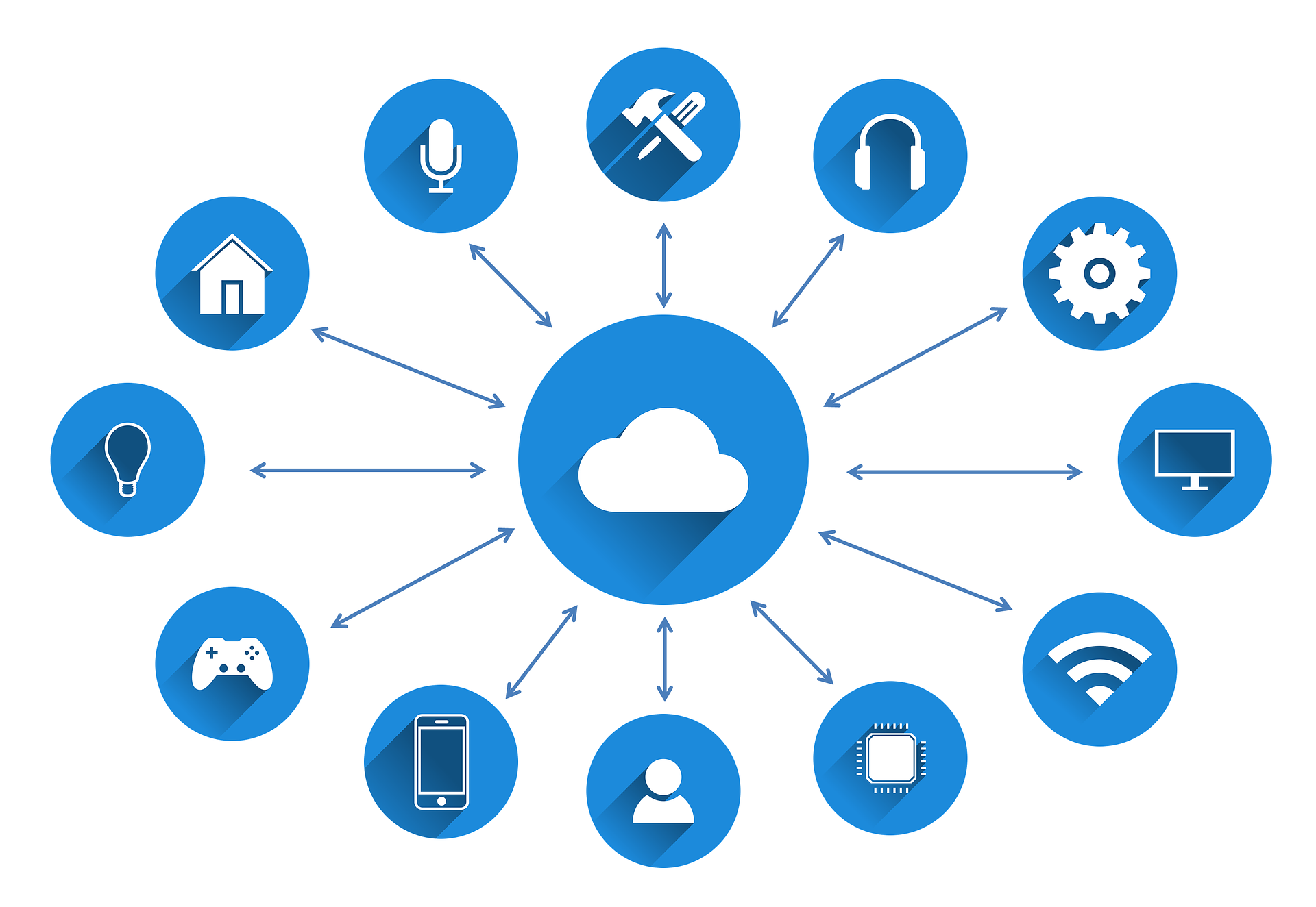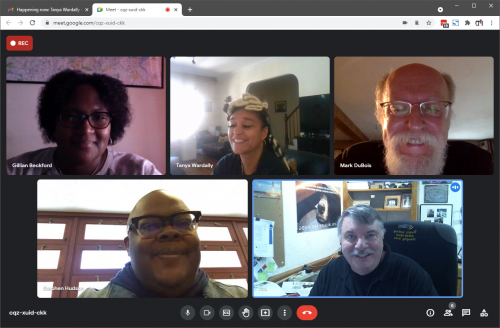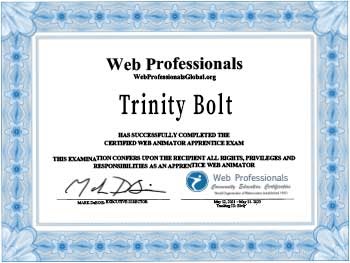
by Steve Waddell | Jul 26, 2021 | Cyber Crime, Industry News
The Internet of Things, also commonly known as IoT, has been one of the hottest tech topics in recent years. IoT devices have a wide range of applications for both commercial and personal purposes including home security, supply chain control, motion detection, energy management, home appliances, health surveillance, and much more. There are an estimated 36 billion IoT devices worldwide, with that figure expected to climb to 75 billion by 2025. Today, it is already a $200 billion industry. Let’s look at some of the statistics and trends driving IoT in 2021 and beyond.
5G Cellular Driving IoT Growth
5G technology has become one of the primary drivers of the IoT, and this will continue in the coming years. By 2024 there will be almost 2 billion 5G cellular subscriptions, and it is estimated that 63% of mobile device subscriptions in North America will be 5G.
New Devices Coming Online
The seemingly exponential growth of both commercial and residential IoT devices will continue as internet-connected devices including televisions, medical sensors, watches, bike locks, alarm systems, microwaves, smoke alarms and even tennis rackets are created and utilized. 127 new devices are connected to the internet every second.
Vehicles and IoT
Research suggests that internet-connected devices will become the norm in the next few years. Nearly 70% of vehicles around the world will be connected to the internet by 2023. In the U.S. the figure will be even higher, with an estimated 90% of vehicles connected to the internet.
Smart Cities Investing in IoT
Cities that embrace new technology like IoT and artificial intelligence will continue to pull away from other cities that have not invested (or don’t have the resources to invest) in this new technology infrastructure. The top 600 smart cities are expected to make up 60% of worldwide GDP by 2025.
IoT and Cybercrime
Research suggests that it takes only an average of five minutes for an IoT device to be attacked after it has connected to the internet for the first time. While the IoT holds great promise for consumers, it also presents new opportunities for cybercriminal attacks.
Business Cybersecurity
Despite the rise in cyber attacks in the IoT, businesses have not fully caught on to how to defend against such attacks. 48% of businesses that use IoT can’t tell when they experience network breaches. This presents an urgent need for developers who know how to spot and defend against network compromises.
Business Investment in IoT
Companies have quickly recognized how beneficial IoT technology can be to everyday operations and are expected to invest $15 trillion in IoT technology by 2025. There are a number of cities as well as companies like health care providers and manufacturers that have invested in IoT technology for the future to stay ahead of the curve.
The Future of the IoT Market
Various reports have suggested that the IoT could be worth $4 trillion, $5 trillion, or even $10 trillion in the next several years. Although the projections differ, they are agreed on one thing—there will be rapid and prolonged growth in the market.
It’s clear that the IoT isn’t going anywhere. Companies in a variety of industries will be in need of trained and skilled web developers and designers who know how to most effectively harness IoT technology to deliver consumers with the technology experiences they are looking for. The Web Professionals Organization is dedicated to all professionals who utilize the internet each and every day as the IoT continues to expand.
by Mark | Jul 1, 2021 | Cyber Crime, Industry News, State of the Web, Web Security
This month, I thought it appropriate to post some of my thoughts concerning web and security. Unless you have been unconscious for a while, you have seen so many news articles about ransomware attacks on various corporations. Since many readers work with clients (both internal and external), here are some of my thoughts regarding security. The sad thing is that most of these attack vectors are nothing new. They have been employed for some time, yet some people still fall victim.
I am focusing on what you can do as an individual. Obviously, this is a very large topic and I am just touching on some of the highlights as I see them. I look forward to your comments and encourage further discussion in our member Slack channels where we can focus on more specific items).
Passwords
- Passwords should be long and complex. If in doubt, length wins over complexity. Consider using passphrases.
- Passwords should be changed on a regular basis. You decide on what is comfortable for you.
- Passwords should never be reused on more than one site. Never. There is no reason why you need to do this.
- If you can’t recall passwords, use a password vault. There are a number of alternatives. Just make certain it is secure and your passwords are updated in the vault as you change them.
- Passwords should never be shared with others. Never. If there is some unusual situation where another must access your information, change your password, give that party the new one, then change the password again once the need for their access has passed. Frankly, I can not think of any situation where this is warranted, but…
email
- Never open links included in email messages. If you receive a link to a website (such as a banking site), open a browser and type the URL. It is so easy to spoof website addresses these days. That is why you should manually enter any site URL where you are required to authenticate.
- Unless you are expecting an attachment from someone, never open email attachments. Never. This is where most malware gets started. I recommend using some form of online storage (which is virus checked) if you must share documents these days.
2FA
- Whenever possible employ two factor authentication as part of your login. In a nutshell, there are three ways to prove you are who you say you are – something you know (like a password), something you posess (like an authentication app), and something you are (like facial recognition or fingerprints). I recommend using the first two in combination since it is very difficult to change your bio-metrics.
Phone calls
- I recommend activating the feature found on modern mobile devices which only allow for incoming calls from those in your list of contacts. Anyone else must leave a voice message. Most scammers rely on a sense of urgency to get you to take an action you would typically not do (for example, say “yes” or share a password. Review the voice message and only call back if you are certain you need to speak with the individual leaving the message. Most scammers will likely not even leave a voice message. I assure you, the sheriff’s department will never call you to let you know they are coming to arrest you. It is best to delete similar junk.
Final thoughts
I know this list is not complete, and should be obvious to readers. However, it never hurts to review the basics periodically. Always apply a healthy dose of skepticism when anyone contacts you and asks you to take action. The more immediate their request, the greater the likelihood it is a scam.

by Steve Waddell | Jun 24, 2021 | Profiles Of Success
 Students at the Boys and Girls High School in Brooklyn, NY recently completed the Web Design for Business and Marketing course and Remote Working Professional course and certifications through a brand-new program offered by the Web Professionals Organization and CTeLearning. The students are the first in NYC to complete the courses, earning integrated industry-recognized certifications and association membership. The students were led by their teacher, Tanya Wardally, who sought out the curriculum and delivered these valuable opportunities for her students. She will be proudly presenting her students their new industry credentials just in time as they leave for a well-deserved summer break.
Students at the Boys and Girls High School in Brooklyn, NY recently completed the Web Design for Business and Marketing course and Remote Working Professional course and certifications through a brand-new program offered by the Web Professionals Organization and CTeLearning. The students are the first in NYC to complete the courses, earning integrated industry-recognized certifications and association membership. The students were led by their teacher, Tanya Wardally, who sought out the curriculum and delivered these valuable opportunities for her students. She will be proudly presenting her students their new industry credentials just in time as they leave for a well-deserved summer break.
Future-Proofing Students
Tanya worked with the Web Professionals Organization and CTeLearning to bring in this courseware to offer to her career and technical education students. She enabled her students to future-proof their professional paths, equipping themselves with the skills needed to succeed in the professional world—no matter how it continues to change. Having technical training skills combined with industry-recognized certifications sets these students up with the hard and soft skills to excel in whatever career path they pursue.
It is fitting that the Boys and Girls High School, the oldest public high school in Brooklyn, is the first in the nation to offer a new way for students to learn and earn career-building industry credentials. Under this new grant program, students earned their certifications as they completed the project-based courses. The certifications were fully integrated into the courses to reduce test anxiety and equip students with the skills needed to succeed, and the certifications were offered at no charge to the school or students.

Through the two courses, students learned coding, design, industry concepts and soft skills as they completed real-world projects and built up their college- and career-ready portfolios. The short-form Remote Working Professional course is mobile-friendly, just four hours long, and features interviews with 30 remote working professionals in a variety of industries who teach students how to be effective workers in the new world of remote work. Having these skills and credentials prepares them well for their futures, no matter what path each of them takes.
Teachers and Students Praise the Courses
Tanya spoke about how important it is to prepare students for their futures: “Today, more than ever, we educators must prepare our students for a dramatically different world of work than when we were in high school. Let’s face it: technology and the pandemic have forever changed the world of work. We have to future-proof them and make them resilient so that they can succeed in any environment. I appreciate how these courses taught both hard skills and transferable soft skills. My students loved being able to progress through the courses from any internet-connected device, including their smartphones. I would recommend these courses to any teachers and students who are looking for curriculum that will prepare students to thrive in their post-secondary and professional careers. I am so proud that they are earning not one but two international industry-recognized certifications this year—even in the midst of a pandemic.”
Alexander W., who completed the Web Designer and Remote Working Professional courses and earned the course certifications, discussed what he learned: “The Remote Working Professional course made me realize that I should definitely find my own space to have more room. I really like having a desk and everything. So I want to make sure I have that setup as well as a glass of water or whatever else I need to be successful when working on schoolwork or learning virtually at home. It also taught me the importance of maintaining a schedule, waking up at a certain time for class and making sure I get my work done. The school should definitely try to get this for all the future students. It most definitely helps prepare you.”
Another student, Christina C., talked about what she learned in the Remote Working Professional course: “The course taught me what it’s like to be in the workforce, such as how to be reliable, trustworthy and work well with other people. I think it is important to be cooperative with other people because in school we have to work in groups when learning online. And with remote working, you have to work with people.”
The Remote Working Professional Course includes an interview preparation module that teaches students how to answer the trickiest questions in job interviews and impress hiring managers. Cheyenne, another student, said one part of the module was especially helpful: “The part that stood out to me the most was learning how to answer the question, ‘Can you tell me about yourself?’ When I tried to answer this in a previous interview, I just shut down. I got the job, but it was a bad part of the interview. I now know how I would answer that question in the future.”
Stephen Hudson, Work-Based Learning Coordinator and Career and Technical Education Teacher for Brooklyn Boys and Girls High School, had this to say about the program: “I‘m not surprised that we are the originators and not the imitators. That is something that we’re very proud of, and I’m proud of Ms. Wardally for spearheading this activity to teach our students in-demand skills. We recognize that while employers are looking for technical skills, there are also soft skills and abilities that our students need to demonstrate. I like to refer to our students as diamonds in the rough. These courses and certifications take them through a process to refine them and prepare them for what they will need in a real-world situation. I’m ecstatic that we’re involved in this certification grant program. In fact, we’re going to have Ms. Wardally talk about this in our upcoming meeting with career and technical education central staff. We are so excited to announce that we are the first school in all of New York City to offer this course and certification program.”

Following the success of the students, the career and technical education team at the Boys and Girls High School met with Mark DuBois, Executive Director of the Web Professionals Organization, and Steve Waddell, lead developer of CTeLearning, to discuss the trends in web design and remote work that the students will now be able to take advantage of. Mark also took a moment to congratulate Tanya and her team for being the first in the country to take part in an innovative program of integrated certifications that can be built on each other.
The mission of the Web Professionals Organization is to support the whole professional. By teaching students valuable skills and not boxing them into a single career pathway, the association prepares professionals to change and adapt as industries and opportunities ebb and flow. The Web Professionals Organization and CTeLearning have been working together since 2013 on innovative courseware aligned to state and national standards that incorporates industry training that is crucial to create the next generation of professionals.
For more information on courses offered by CTeLearning, visit here and here.
by Mark | Jun 1, 2021 | Industry News, Web Professional Trends
As we begin another month, here are my thoughts regarding what is happening in our industry.
This month, my thoughts center around longevity. Hope you find this information useful. In case you are curious, I built my first web page in 1992 (yes, 29 years ago). It no longer exists, nor does the company where I built it at.
I am already looking forward to your comments.
Ageism
My colleague and friend, Tom Green, recently posted an article on LinkedIn.com about this last acceptable prejudice.After you review the article, let’s start a discussion in our Slack #general channel about this topic. What are your experiences? Does Tom’s article resonate with you? Why or why not?
CSS
Eric Meyer reflects on 25 years of CSS. Has it really been that long? If you have a moment, please post a comment reflecting on your first use of CSS. Consider a discussion in our Slack channel as well. What are your thoughts on the past 25 years of CSS.
WordPress
Speaking of longevity, WordPress turned 18 in May. Isobel Weston has a great overview article at NameCheap. From a simple blogging platform to a technology which powers nearly 41% of the WWW these days. And it only took 18 years to get to this point. Makes me wonder what the next 18 years hold for this technology.
Annual Web Competition with SkillsUSA
Speaking of longevity, this year marks the 19th year for our national web competition held in conjunction with SkillsUSA. Our first year (2004) was a demonstration contest. This year will mark our first large scale virtual competition. We did a smaller competition in 2020 as the pandemic raged. This year, we have over 20 teams competing at secondary and post-secondary levels. Winners will be announced near the end of June at the above site.
I am curious – now that you have read this far, what information would you like to see next month? Please tell us via the comments.

by Steve Waddell | May 28, 2021 | Profiles Of Success
The Web Professionals Organization has certified six students of Lakeview Leadership Academy High School in Victorville, CA, who recently completed their Web Animator Apprentice certifications. These students have taken a step toward building their college and career-ready portfolios in one of the most exciting and rapidly growing STEM fields.
Lakeview Leadership Academy High School Animation Instructor Nikki Jarvis utilized the Web and Computer Animation course from CTeLearning to jumpstart her students’ interest in animation. The media-rich course guided students through the course, and culminated in them earning international industry-recognized certifications (IIRC) that get learners excited about the world of animation and open their eyes to potential career paths.
Congratulations to Ms. Jarvis and her newly credentialed web animators:
Trinity B.
Jorge E.
Adalit M.
Diana H.
Jenna G.
Kimberly C.
The certification course delivers the training using a virtual internship model, which immerses the students in interactive story-based projects that look and feel like a career simulation. This provides students with a taste of what working in the real world is like. As the students live this experience, they learn the technical and soft skills necessary to be career-ready. Each student at Lakeview Leadership Academy High School was tasked with building their portfolios to prepare for their futures.
This immersion in the design process gives each student a personal story of success they can tell as well as insights and best practices they take with them to help ensure they are truly college and career-ready. In the 2021-2022 school year, a special industry partnership spearheaded by the Web Professionals Organization will be underwriting the expense of these certifications for all students who complete the required course and project work at schools across the United States.
The fact that professional industry association certifications carry far more weight than those from testing companies was one of the primary drivers behind Lakeview Leadership Academy High School deciding to offer certifications backed by the Web Professionals Organization. A job applicant with an IIRC lets the interviewer know immediately that he or she has the hard and soft skills required to succeed in the job, which will save employers who hire these students time and money spent on training.
Praise for Lakeview Leadership Academy
Mark DuBois, Executive Director of the Web Professionals Organization, said, “A few years ago, Ms. Jarvis’ students were the first in the U.S. to receive our Web Animator Certification. Since then, she has added to the ranks of learners who have received the stackable international industry-recognized certification from CTeLearning. This means that they can stack certification levels and continue to grow in their skills. The Web Professionals Organization has always delivered the message that being a successful professional takes more than just technical skills. To back this up, our Animation certification focuses not only on the technical skills of animation, but brings together ethics, creativity, problem-solving, marketing, and storytelling. Professionals in industry recognize how important and powerful an interactive message is to their client’s products and narratives. As professional web animators, designers, and technologists, we are always striving to do the best for our clients. On a personal note, I just love seeing the next generation of professionals getting started with their first set of credentials from us.”

One of the recipients of the Web Animator Apprentice Certification, Trinity Bolt, discussed how earning the certification has changed her future outlook:
“Thank you so much! I feel blessed for the opportunity, and I still cannot believe this is real. I was so excited when I heard I had earned my certification, and I instantly jumped up and told all of my family, even though they were sleeping. My brother wished me good luck, and when I told my mom, she was so proud that she ended up crying. All of my household knows I want to push myself in school and get as much credit as I can. Since college is really expensive I have been working to make my record look impressive so I could possibly get a scholarship. I wouldn’t have been able to get this good grade and privilege without Mrs. Jarvis helping other classmates and me with our schoolwork! I’m very happy that I passed the test, considering I was nervous during the entirety of it. Before I even joined this class, I had no idea how to animate and the skills it requires. With just a little dedication and practice, I have made it this far. I am so humbly proud of myself and look forward to how this will help me in my future. Hopefully I can work with Mrs. Jarvis and the others who have helped me, even after I graduate. Everyone around me has really helped push me to go for my dreams, and move onward. Thank you to everyone who helped me get here!”
Animation instructor Nikki Jarvis was able to double her program size when word got out that an exciting Animation course was being offered. She is continuing her mission to bring relevant credentials to her students. Nikki discussed her experience administering the course to her students: “My Lakeview Leadership students shined through what was a tough year between the pandemic and lockdown. I am blessed with great students that I am proud of. This year’s group of certification recipients now have industry-recognized credentials—international no less—as part of their portfolios. When these students apply to college, they can proudly list this certification. When they apply for a job, they will list this credential. This is just one more thing that makes them unique and helps them to stand out from the competition. I must thank our administration for all their support. To Dr. Chamberlain and Dr. Collins, thank you so much for all your stellar support. Our program would not be here without you. I also want to thank all the parents who have been so supportive of all our young Spartans. On behalf of my students and our whole teaching team, I want to thank the Web Professionals Organization and CTeLearning for the grant that paid for our students to take the credential exams. This was a tough year for all of us, and the grant did make it better. Thank you.”
Dr. Mauricio Castillo, STEAM Researcher at California State University, Los Angeles, said, “We hope to see these students here at CSULA. The Lakeview Leadership students completed a true STEAM project-based learning experience, and they even earned international industry-recognized certifications. Each of Ms. Jarvis’ students have a standing invite to come and check out our university—you are the students we love to have.”
by Mark | May 1, 2021 | Industry News, State of the Web, Web Accessibility, Web Content, Web Professional Trends
Note from Mark. I plan to periodically provide article summaries and insights. I am hoping this will happen once each month. Hope is the operative word. Here are my thoughts as we begin May, 2021. I welcome your comments about additional topics you would find helpful as well as your thoughts about these articles. I found them most interesting/ thought provoking.
Accessibility
Using Modern CSS to Improve Accessibility. This article by Stephanie Eckles provides a quick overview of what it means to have an accessible website. Stephanie then covers using some of the newer CSS to enhance accessibility. This includes use of outline-offset to position the outline away from the element. The focus-visible pseudo-class will display an outline only when the user agent determines it needs to be visible. There is so much more in this article, I encourage you to set aside time to read it in its entirety and digest how these CSS features can be used to solve real world accessibility issues.
A.I.
GPT-3 is a language supermodel which is quietly ushering in the A.I. revolution. This article by Luke Dormehl explains why this text generating algorithm makes a difference. The main difference with prior algorithms is that limited training is required. In the past, significant input was required for A.I. to “learn.” This no longer seems to be needed. Think. About. That. Here is a key quote from the article (it certainly resonated with me).
“Machine learning has been transformative in all sorts of ways over the past couple of decades. But machine learning requires a large number of training examples to be able to output correct answers. GPT-3, on the other hand, has a “few shot ability” that allows it to be taught to do something with only a small handful of examples.”
Ok, Mark, what does all this A.I. have to do with Web design and development? One example mentioned in the article is a layout generator which”renders a functional layout by generating JavaScript code from a simple text description.” Another example is a GPT-3 based search engine. I think you will find this article most interesting and informative. Our industry is changing and A.I. is going to have a major impact. Plan accordingly.
FLoC
Federated Learning of Cohorts is Google’s replacement for tracking cookies. Our advisory board member, Deborah Edwards-Orono, has a great article about this effort and her concerns. Simply put, FLoc is included by default in the new version of the Chrome browser [see our recent post on the popularity of this browser] and collects your recent browser activity. It takes that activity and labels it then shares the “cohort” with other websites and advertisers. The main concern with this approach is privacy. She also discusses a new WordPress plugin Disable FLoC which is easy to install and has no configuration settings, it just does what it claims to do. If you would like to learn more about the implications of FLoC, the Electronic Frontier Foundation has a solid overview as well.
For those not using WordPress, Marko Saric has an overview article at Plausible which also includes the snippet of code you can add to your .htaccess file to disable FLoC as well.
Future of the WWW
Professor Sir Tim Berners’Lee (inventor ot the WWW) thinks his creation is out of control. In this interview, he explains his plans to save it.The big issue these days is privacy. He proposes Solid (a new system to decentralize the Web). His core idea is PODS (Personal Online Data Stores) which each person has control over. The fundamental change is that anyone wanting to use your information must ask for your permission. After you review the interview, I would be keen to learn your thoughts about this approach. Comments are open.
Hardware
Gizmodo recently discussed the fact that Verizon is recalling 2.5 million of its hotspots because they are literally too hot. There have been 15 reports of the devices overheating (6 instances of fire damage). Review the article to see if you have one of these hotspots (various models sold between April, 2017 and March, 2021).
WordPress
Easy WP Guide has been released for WordPress 5.7 (most current version). No discussion of PHP or the technical details, just a comprehensive guide to help you edit the content of your site. This is a free download. Web Professionals who build sites using this technology may wish to share this document with their clients (if you haven’t already). You can purchase the guide which allows you to brand it as you wish.
For those developers using Elementor as part of their WordPress installations, you may wish to review the recent Wordfence post discussing recent vulnerabilities with Elementor. For those who are not aware, Elementor is installed on over 3.5 million WordPress sites. The Wordfence team found over 100 vulnerable endpoints.
Final thoughts
Hopefully, you found these articles and insights helpful. What else would you like to see in future articles? What did you think about these? I look forward to reading your comments.
Best always,
Mark DuBois, Executive Director
Web Professionals (a.k.a. World Organization of Webmasters)

by Steve Waddell | Apr 28, 2021 | Industry News, IT, Search
The internet! Completely useless without a single piece of software. Well, maybe not completely useless, but it wouldn’t be the service we enjoy every day. Accessible, easy to use, and easy to find content.
Much of this is down to a single type of software, the web browser. It does what it says, allowing you to search and browse the internet. Taking what would be a bunch of ugly HTML files written in confusing code and rendering them into something we can all understand and interact with.
There has been a long-standing joke in the community, about the ‘other’ web browser. Some people call it Internet Explorer, and others call it “The Chrome Downloader.” This is because Google Chrome has a 67% of the market share. This is incredible when you consider that Internet Explorer—and more recently Microsoft Edge—browsers come preinstalled on every Windows computer. That means 67% of the market makes an active choice to ditch that Microsoft browser and install Google’s Chrome browser instead.
Microsoft recently based its newest version of Microsoft Edge on the Chromium Browser, which is the open-source project that powers Google Chrome. Safari, Internet Explorer, Microsoft Edge, and Firefox—four web browsers that get completely dominated by Google’s offering.
A Brief History
But how did this come to be?
Back in 2008, the picture was very different. Internet Explorer was the dominant browser. In fact, it had 64% of the market around this time. But Internet Explorer was unstable, prone to crashes, and had many problems. Firefox was running as the second browser of choice—it was open source and more stable. However, both browsers suffered from the fact that they had been around for a long time. Firefox came from a browser lineage that was even older than Internet Explorer. When Netscape decided to release the source code of its dying browser to the open-source community, Firefox was born.
Because both these browsers came about within a year of each other, Netscape came out in 1994 and Internet Explorer 1 came out in 1995. They suffered from the same stale internet ideas that had been present throughout the ’90s—the idea that the internet was designed to show you pictures, some video and a lot of text, then link you to the next thing.
Google came in at a time when the internet was evolving into something a little different, seeing the internet as a platform not unlike an operating system—and, of course, this philosophy has come to pass with Chrome OS, as it is an entire operating system effectively based on the internet.
Google saw the web as a location to play games, run applications and operate services—and it very much treated it that way. The company created Google Docs (a replacement for Microsoft Office) Google Maps (a replacement for AutoRoute) and many other application services. While these products didn’t come until later, it can be argued that without Google Chrome’s application-focused approach, many of the services wouldn’t exist today.
Google Chrome was built from the ground up with applications in mind. To this end, Google began poaching Firefox developers as well as experienced developers from the Netscape team, and they were put in charge of the project. Their job was to create a new browser from what was deemed Web 2.0 at the time.
While the Chrome team faced the problem of creating brand new technologies from scratch, the approach proved advantageous because their rivals Microsoft and Mozilla were both trying to make better browsers too—but they were reworking legacy technologies instead of creating new ones.
This allowed the Google team to focus on building their own custom tools, without any of the “but we’ve always done it this way” arguments.
The biggest difference between Google’s approach and the others was the invention of the sandbox. The sandbox is Google Chrome’s biggest advantage. Every time a new tab is opened in Chrome, that website is run inside a sandbox. It is completely isolated from the rest of the browser. By isolating them, no two tabs could communicate with or interfere with each other. If you landed on a bad website, the tab would be forced to close or freeze—but nothing else in the browser was affected.
The drawback to this approach lives with us today. Google Chrome takes up a lot of memory every time it creates a new sandbox environment for a web page to load in. But the improved stability proved a greater boon.
Google called upon a massive community of open source developers by beginning the Chromium project in 2008, allowing the company to effectively gain free labor from the open-source community. This allowed Google Chrome to align with open-source community web standards.
Because they made the project open source very early on, the browser became very popular with the developer community. Because it was open-source it was much easier for developers to understand how the browser worked, allowing them to push the limits of web technologies in ways you couldn’t do with other browsers. The result was an ever-growing number of web apps that worked extremely well with Google Chrome but poorly with other browsers. This gave the average user even more reason to download the browser if they wanted their favorite web app to work right.
By July 2009, just nine months after Google officially launched Chrome, they had 30 million people browsing the web. This was when Google announced the Chrome Operating System.
In December of the same year, Google released the extensions gallery which allowed the browser to be extended with extra plugins and extensions quickly and easily.
The extensions provided a welcome replacement to the myriad of toolbars you could install in other browsers, which often created cluttered interfaces. Some toolbars would even cause the browser to crash outright upon loading. Google’s approach was far more streamlined and simple.
While all this was going on, Microsoft was being attacked by the U.S. federal government over anti-competitive practices. The government argued that bundling internet explorers into Windows was just a way to dominate the market. Google capitalized on this by giving everyone a choice to install their browser. By 2010, Microsoft was forced by the European Commission to provide an alternative choice to the standard Internet Explorer. Windows users were faced with a new window offering them a browser of their choice.
In 2010, the Chrome Web Store replaced the Chrome Gallery. It was a bigger and better incarnation of the feature that is still around today.
One of the oldest browser extensions is Adblock Plus. The extension could be argued to have created the online subscription model we see more and more today as ads are blocked in browsers.
But in 2015, the combination of the clean interface, fewer crashes, better extensions, and a growing collection of web apps that worked best in it resulted in Chrome browser increasing its market share to 52%—more than all the other browsers combined.
Over time, Google has created more and more web services including YouTube, Drive, Calendar, Docs, Earth, Maps, and much more. Chrome is no longer a simple web browser. It is a gateway into Google’s ecosystem of online services, many of which are completely free to use.

by Steve Waddell | Apr 15, 2021 | Job and Resume Tips from the Pros, User Experience, Web Design, Web Development
People often think that web development and web design is an industry that is only for young people. Many start-ups and tech companies are run by people in their 20s and 30s, so this is a common belief. However, there will always be a need for web developers and designers by companies across a wide variety of industries. If you have the skills and determination, companies will give you a serious look—no matter how old you are. Companies often don’t care about what you have done in the past, so you can learn web development and show companies that you can help them meet their goals—even if you are switching from a completely different industry. If you are in your 40s, 50s or older and thinking about taking the plunge in learning web development or design, here are some tips to keep in mind during the process:
Identify Your “Why”
If you can identify why you want to learn web development or design skills, and have a goal in mind, you will be much more likely to be successful. Perhaps you are a lifelong learner and want to dive into a completely new field. Maybe you feel like learning web development or design will help you perform your current job better. Maybe your company has open positions for web developers and designers, and you feel like you would be a good fit if you had the skills. Or maybe you would like to begin freelancing for companies for side income and have realized that these are an in-demand skill companies are always seeking.
Get Started
A web developer works on the structure of websites and is responsible for coding more of the back-end (server side) of the site. A web designer works more on the front-end (client side), creating the look and feel of the site and taking the client’s product or service to the web. Web developers are engineers and mechanics, while web designers are architects and storytellers.
Find a program that teaches the programming languages you are interested in. If you are new to coding, then starting with the front-end of web development like HTML5, CSS3 and JavaScript is the perfect way to ease yourself into the industry. Both web developers and designers need to know these languages first and foremost. This makes front-end development the best place to start, as you can see on the screen in real-time how your coding is performing. After mastering the front-end, you can explore the back-end of development too.
There are a ton of resources available online for those interested in learning web development skills. Some online coding classes allow you to learn at your own pace, while others allow you to learn with an instructor alongside other students in a “bootcamp” model. If you learn better in an in-person setting, your local community college may offer courses either as part of a credit degree program or through their continuing education departments.
Some programs of study may encourage you to quit your current job to be able to attend the program. If this is the case, you may elect to take an online program that will give you more flexibility to learn at your own pace, anytime and anywhere.
When selecting a program, make sure you will earn an industry-recognized certification at the end of it. A simple course certificate doesn’t hold much weight, but a certification that is backed by industry professionals will be much more credible to companies seeking to hire developers and designers. And be careful of expensive bootcamps—some are worth it, while others are not. Put simply, you need to want to put in the work to become a developer or designer. If you just go through the motions of learning, you will not come across as skilled and confident when interviewing with companies. Accomplished developers and designers have a passion for coding and continuing to learn and hone their skills over their careers.
Find Help When Needed
If you enroll in a web development or design bootcamp or local community college class, you will have built-in support with a teacher and your colleagues. However, learning web development individually at your own pace can be difficult. Try to find people around you or online whom you can bounce questions off of and seek guidance from. This could be a family member or friend who is a software engineer, or it could be someone else who has completed the course you are enrolled in. Having a mentor can make the learning process much easier and spur you to continue on for the times when you are feeling defeated.
Ways to Stand Out
When you start as a web designer (and later think about web development), it is important to remember there are many who are also aspiring. How do you stand out in the field? One approach is to learn more about web accessibility (making web pages accessible for those who use assistive devices). Another area you could consider is learning how to make web pages more easily found and indexed by search engines. Perhaps you want to check out schools and curricula which focus on these topics?
You may also be asked to show a portfolio of your work. Obviously, you will have examples from the classes you take. However, you may also want to offer your help to not-for-profit organizations. While you may not be paid for your help, you will gain significant experience in working with actual clients. Also, you can always ask the organization for a letter of reference (once you have successfully completed your project). We encourage you to think about ways to differentiate yourself from others. What can you do better than most? Leverage that as you learn web design and development.
Have Fun
The world of web development and design is an exciting one. Developers and designers work to make the apps, websites and games we rely on every day function as they should. They often get to work on cool projects that are at the cutting-edge of how we work and play on the internet, and you can be a part of that.
There’s a reason web developers and designers get paid well—it isn’t always easy to learn and do well. However, with a willingness to learn, determination and support system, it’s never too late to dive in. Whatever path you take, developer or designer, our Web Professionals organization looks forward to welcoming you to our community.

by Steve Waddell | Apr 11, 2021 | Industry News, State of the Web, Web Development
Three months into 2021, there are several web development trends that have clearly emerged. The digital market is competitive, and it’s important for developers to stay abreast of the latest trends impacting the industry. Let’s take a look at the trends that all web professionals should be aware of in order to stay ahead of the competition through the rest of 2021.
Artificial Intelligence and Bots
AI and bots continue to be used more than ever before by developers. Their ability to collect data, learn about users, and solve issues with human intervention make them highly attractive for companies seeking to streamline operations and customer service. Today’s consumers expect 24/7 service, and AI can deliver just that for companies seeking to maintain their engagement with customers while saving money. AI and bots can be incorporated into sites and mobile apps for a wide variety of devices. Staying on top of the latest in AI and bots can give your company a leg up on the competition.
Voice Search Optimization
Today, many internet users access web services without typing or even looking at the screen of a device. People can control garage doors, lights, security systems, thermostats and much more just by talking to a smart device in their home. It’s clear that voice recognition will continue to be an important aspect of web development for years to come, and it is estimated that as many as 50% of households with internet access will utilize a voice assistant by the end of 2022. Companies are in need of developers who can create web services that are accessed by voice command.
Accelerated Mobile Pages (AMP)
The primary idea behind this technology is to speed up page performance to keep the user engaged with the mobile site and reduce the chance that the user leaves before the site page loads. Essentially, AMPs are optimized pages with a simplified and scaled-down design. This allows the pages to load quickly while only displaying basic features. They have easy-to-read content and are formatted to work seamlessly with smartphones and tablets. AMPs level the playing field for users, as even people with slower internet speeds can access and enjoy AMP features.
Automation Testing
This helps developers test their products more effectively than the traditional manual testing. Put simply, web development is judged by how fast and efficient it is for the use. Automation testing promotes better testing coverage, makes the development process cheaper and reduces the time of the test cycle, allowing smaller web development companies to compete with those with more resources. This form of testing also creates a better user experience and allows developers to more quickly and efficiently identify issues.
App Accessibility
This trend is about making web applications more accessible for consumers, organizations and businesses. Single-Page Applications (SPAs) are on the rise, as they don’t require users to reload the page while using it. An example of a platform that uses SPAs is Facebook. As users scroll down, new content appears automatically. Another growing trend is the use of Progressive Web Applications (PWAs), which offer stripped-down versions of native applications with the benefit of not requiring the user to download a new app. PWAs are cost-effective and can deliver users an easy experience.
These are a handful of the trends that will drive web development through the rest of 2021 and beyond. As a web professional, stay on top of what is going on in the industry so you can stay a step ahead of the competition.

by Steve Waddell | Mar 30, 2021 | Cyber Crime, Web Development
March 2021 has seen 10 vulnerable plugins and themes for WordPress sites, which has affected about 400,000 total websites. Running WordPress sites requires keeping up to date on the latest security vulnerabilities and fixes like the ones below.
Although these vulnerabilities have received a virtual patch to the WebARX firewall, to be safe you should update or delete the plugins immediately from your site.
WooCommerce Upload Files Premium
Enables users to upload files, preview images, add additional fees, and more. Vulnerability affects over 5,000 sites.
Solution: Update WordPress WooCommerce Upload Files premium plugin to the latest available version.
User Profile Picture
Sets/removes profile images for users using the standard WordPress media upload tool. Vulnerability affects 60,000 sites.
Solution: Update WordPress User Profile Picture plugin to the latest available version.
Forminator
Form builder for WordPress. Vulnerability affects 100,000 sites.
Solution: Update the WordPress Forminator plugin to the latest available version.
Dokan
WordPress marketplace plugin. Vulnerability affects 60,000 sites.
Solution: Update WordPress Dokan plugin to the latest available version.
Defender Security
Security plugin for WordPress. Vulnerability affects 50,000 sites.
Solution: Update WordPress Defender Security plugin to the latest available version.
Abandoned Cart Lite for WooCommerce
Helps recover carts from WooCommerce shop. Vulnerability affects 30,000 sites.
Solution: Update WordPress Abandoned Cart Lite for WooCommerce plugin to the latest available version.
Style Kits for Elementor
Adds UI controls to Theme Styles for layout systems in Elementor. Vulnerability affects 10,000 sites.
Solution: Update WordPress Style Kits plugin to the latest available version.
WP ERP
WordPress business management solution. Vulnerability affects 10,000 sites.
Solution: Update WordPress WP ERP plugin to the latest available version.
WP Project Manager
WordPress project management tool. Vulnerability affects 10,000 sites.
Solution: Update WordPress WP Project Manager plugin to the latest available version.
WP Travel
Travel engine for making customized travel websites on WordPress. Vulnerability affects 6,000 sites.
Solution: Update WordPress WP Travel plugin to the latest available version.
We at the Web Professionals Organization are not endorsing WebARX, but they have put together a great list from their research and work in server security, protection and monitoring. For more information on these vulnerabilities on the WebARX site, click here.










